For many people, radios at home, in the car or wherever are simply there to hear and listen to music, news or sports. For them the words radio and receiver are almost interchangeable. However, in the amateur radio (aka ham) world, given our desire for two way communication, our radios are made up of two distinct parts; a receiver and a transmitter, most likely in a single device and if not almost certainly physically co-located.

Receivers in all radios are remarkably sensitive, picking up very weak radio waves that have most likely having travelled enormous distances from a transmitter, decaying in strength along the way.
Conversely, transmitters in radios are brutes, pushing out enormous amounts of power to create a radio wave that can travel far and wide and overcome the inevitable distance related decay, hopefully not beyond the minimum level a receiver can detect.
Think of someone shouting. As irritating as they are to a neighbor, a person 500 yards away isn’t even aware a syllable was muttered. Like sound waves, radio waves rapidly decay in strength over distance.
It shouldn’t therefore be surprising that operating a radio’s transmitter in close proximity to a separate radio’s receiver can irreversibly destroy the later. The transmitter’s radio wave is simply too strong for the sensitive receiver circuitry to deal with. Gone, good bye followed by a huge repair bill. The solution is some “fancy” electronic stuff around the radios to protect them from each other either alternating
Building on the shouting analogy, remember stories of people going to rock concerts and wondering what happened to their hearing later that night possibly wishing for ear muffs?
Why are two better than one?
Given the consequences and the possible complexity and hassle to enable two radios to operate and co-exist you might be wondering, “why bother”.

In the competitive world of ham radio contesting, most/many/all of the top scores for single operators are achieved using great antennas, a great location, tenacity, skill and two radios setup for simultaneous operations using a configuration colloquially described as Single Operator Two Radio (SO2R). Simplistically two roles exist during a contest; the caller and the responder. Not everyone is in a position to be an effective caller as it typically requires a “loud” station or someone at a destination that is highly desirable to contact during a contest. A caller is typically soliciting contacts by “sitting” on a single frequency and repeatably calling CQ and hoping a responder will do just that. By corollary the role of the responder is typically to listen up and down a band searching for callers and answering their call. Its potentially easier and less intimidating to be a responder as effective callers can have what is called a pile up of responders all vying to get logged. Often times contests are periods of frenetic activity sandwiched between long slow periods of almost boredom. During the slow times an effective and skilled Caller can use their second radio to act as a responder, searching up and down a band for other stations to log. The benefit is more contacts, possibly high value contacts that ultimately drive the overall score up into first place.
I am no world class contester, far from it in reality, but a station of this nature has tremendous operating upside for a small group of Suitcase DXPeditioners that head to exotic locales to participate in a contest and before/after when operating outside of contest rules.
Slow time, beginners SO2R
During a graveyard shift, while all team members bar one are asleep, it’s easy to see the advantage of being a caller with limited responders on one band (say 40m) and use the second radio to search for other callers (I’m now a responder) on a different band (say 80m) and jump in when a valuable score multiplier shows up.
Busy time, two operators, two separate radios
During one of those frenetic periods when the primary radio operator is calling and logging responders the second radio might well be sitting ideal. This is a perfect time for another team member to search other bands and get a sense of contact (and hence score) opportunities that they could nab in coordination with the primary operator or simple make the primary aware of the opportunity during a momentary lull.
CW and SSB during contests such as CQP or IARU
Some contests such as the California QSO Part (CQP) and the IARU are mixed mode allowing operators to interleave using voice and morse code. Technology has advanced to the point that software can generate and sometime recognize morse code signals (dits and dahs). This opens up the possibility to use/operate morse via a computer as a responder while focusing heavily/primarily on voice as a caller.
Non contest, digital FT8 on one radio and voice on another
One scenario here is running the super effective and fashionable digital mode (software program to software program communication over the air) FT8 on 160m and voice on 80m at night. Each maybe a slow process but together you can be kept quite occupied and take full advantage of being at a desirable locale.
How did I even get to this point?
Like many things in life arriving at the decision to build an SO2R station was as much accident and serendipity as it was by design.
On my first trip to Costa Rica in early 2017 my team mates designated my Elecraft KX3/PX3/KXPA100 the contest station of choice. Without a doubt the KX3 et al is a fabulous station but in fairness the competition consisted on the venerable Yaesu 857D and other workhorses. Bit of a one horse race!
After the Costa Rica contest I began to think more about station design and possibly improving it and hence our performance. Visiting Ken K6LA/VY2TT station really piqued my interest to the point I started digging deeper into SO2R.
Band awareness or lack thereof ….a real deficiency
Despite doing remarkably well as a four person team one Achille’s heal was our inability to see what’s going on on neighboring bands. The big unknown was really the condition of 10m especially when 15m was on the other side of greatness and beginning to yield less contacts. Should we head back to 20m, try 10m while losing valuable contacts on 20m or even stay on 15m? Having a second receiver in the SO2R mold would have facilitated that answer. Despite this we did late Sunday afternoon find 10m open and racked up a slew of multipliers and hence a bigger score.


Break that radio and you’re dead in the water!!
I’m feeling great today, I’m sure I’ll feel great tomorrow until you don’t. We take so much for granted about life, gear etc and the obvious thought that crossed my mind was what if my KXPA100 died or my KX3. Then what….we are using the 857D that someone else brought? Having lived in the world of enterprise and service provider cyber security the value of High Availability (HA) (aka redundancy) isn’t lost on me and so I have convinced myself I (we) should bring two full KX3/PX3/KXPA100 stations so we can survive a device failure.

The other obvious thought is one, two, four etc people have laid out cash and taken time to travel and participate in a contest which is time sensitive (once missed you don’t get a “do-over”) and if that is jeopardized by a single point of failure, more fool us.
You have two KX3 stations. Surely, SO2R is a hop, skip and a jump away?
Well, that was the thinking, that SO2R can’t be that hard and solves my HA concern and guess what I get band awareness to boot. Life is looking very good. Just need to design and build that little thing.
Intent established, what are the goals and basic design?
In fairness, I hadn’t got a clue what all is needed nor makes up an SO2R station beyond two radios. With that, the first goal was to read enough and figure out what’s what in this new world. Optimism and confidence can be a dangerously intoxicating pair but then again it hasn’t really failed me in the past. Tally ho!
Reading, back issues of The National Contest Journal was rewarding and informative as were the many web sites such as RemoteQTH, ArraySolution, DXEngineering and MicroHam.
I’m not sure the penny had dropped and to some extent I took it on faith that all the building blocks were needed and felt experimenting bit by bit was valuable to getting the penny on the ground. A good example was building the Elecraft Band Decoder. I knew I needed one but just wasn’t 100% clear how it worked especially when driving other system components like the 2×6 antenna switch which once again I built on faith and got to work. As noted, optimism and confidence are seductive partners.
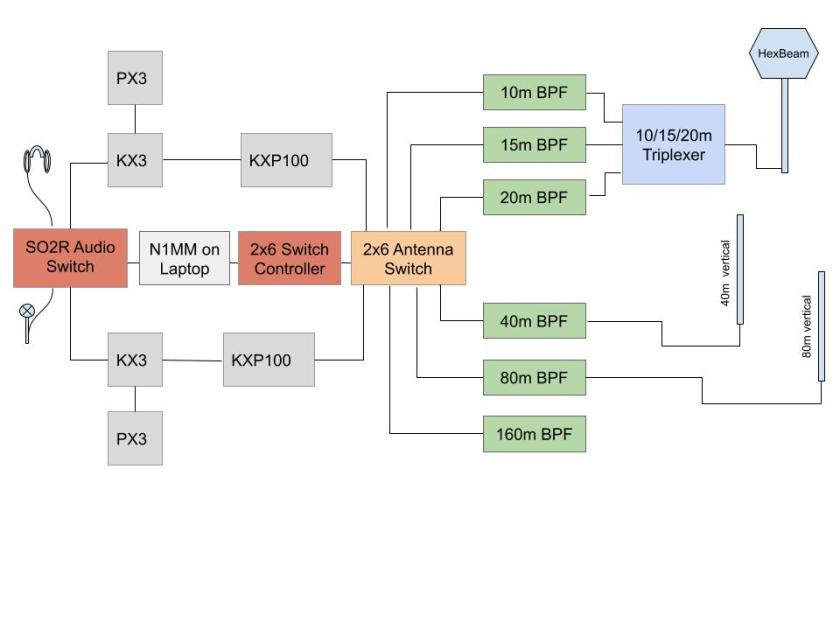
Re-use what you have KX3/PX3/KXPA100
I’m a huge Elecraft user and fan, having enjoyed the KX3 on countless Summits on the Air (SOTA) and National Parks on the Air (NPOTA) activations. I’m sold on it as the radio of choice for this project based on performance and portability.
Simplify spaghetti junction that are the wires between KX3 and the PX3 / KXPA100
Getting this trio of devices to work as one requires an irritating medley of wires. Having a pair of KX3 stations and overlaying SO2R requirement of connections and cables makes for quite the Spaghetti junction that is a pain to setup and less than satisfying to stare at during a contest (I’m a neat-nick). Addressing this in my Suitcase station is a high priority. If the KX3 ever sees a version 2, I hope Team Elecraft simply the connections, doing so could even free up space for a receiver only antenna port (hint, hint).

Use N1MM
As my primary goal is contesting from a remote locale, N1MM is going to be used and hence leveraging it’s SO2R approach was mandatory. This became more apparent as I learnt the finer aspects of the OTRSP protocol when designing and building the SO2R audio switch and 2×6 antenna switch as then are passing commands like AUX100 etc.
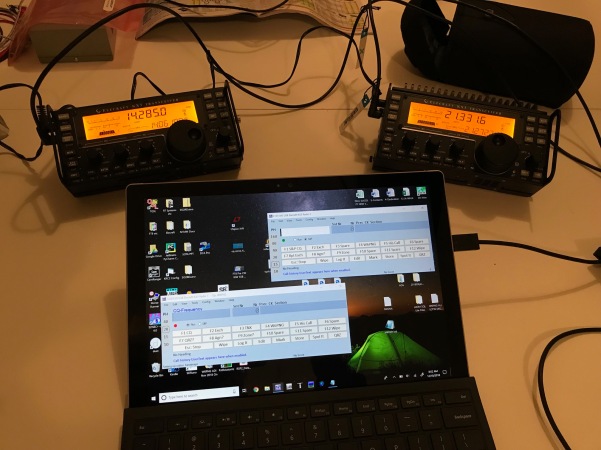
Transportability, weight and volume are key drivers
I can easily get two KX3 and two PX3 into a shoulder bag with adequate projection when traveling by car, foot, train or plane. In addition the KXPA100 (probably two) will go in my carry on wheelie in essence meaning the two KX3/PX3/KXPA100 are carry on. Tough to do with a couple of K3.
Tabletop and Jeep operation equally supported
I’ve taken and operated a portable station from over 200 mountain tops across the US and Europe as a part of the Summits on the Air (SOTA) program. The wilderness offers great views, fresh air, large amounts of land for a station and no electrical noise. Using my Jeep to transport and then host a contest is a long standing desire. Building a suitcase DXPedition station that supports both classic plane journeys and off-road is a goal.

Build versus buy
In a perfect world I would rather have purchased everything. It’s not a lack of interest in building but partly a view that if it exists, building my own is of less value but also commercially available means replacement is easier. However, many of the commercial sources have great gear but its all huge, bulky and heavy. A 2×6 switch could almost occupy a single checked bag and too boot many had sharp pointy corners or brackets to mount somewhere. With that I ended up with the following build/buy.
- Buy
- Make
A better way to mount the radios
Contests can last as much as 48 hours and even with multiple team members you end up with a lot of “seat time”. Ergonomics is very subjective and personal. Understandably, bad ergonomics and accelerated fatigue go hand in hand. I like to be able to see and touch all that is potentially important to being effective without unnecessary reaching, slouching and body twisting.
Our first year in Costa Rica (2018) had us operating on a round garden table in a gazebo. Fun, hot during the day, cold at night and awkward.

While the second year (2019) was from within the house, two radios and pan adapters were once again located to the right of the logging laptops and generally awkward to interact with made more so by my less than brilliant idea to mount one station on a pair of plastic shoe boxes. Every button press had the station inching closer to the back edge of the table and disaster. In addition my two team mates viewed the jungle of wires with a certain amount of disdain and thought my partial SO2R solution a dogs dinner (I hadn’t completed the 2×6 Switch and controller in time).

If you have read any of my other posts you know I own and love my Jeep Rubicon. It’s fun, it’s liberating and All American. One of my two favorite YouTube channels is TrailRecon hosted by Brad. So much fun to watch and in one of his videos he shared 67 Design as a solution to mounting a cell phone in a Jeep and not have it ejected into the cabin while traversing a bumpy road (this has happened to me too often).

It quickly became apparent that I could probably built a stand for the two KX3/PX3 combos and locate them above my logging laptop to realize a quite ergonomic solution.

Fair away locales have lots to offer but the Good Olde USA has a few operating opportunities that scream Jeep. ARRL Field Day being the obvious but personally one of deep interest is the California QSO Party which is the largest State side QSO party. One category within that is a multi location DXPedition and given how far into this Suitcase Dxpedition area from a gear perspective I am my goals extended to include once again what appeared to be a hop, skip and a jump beyond where I was. With that I set to expanded the 67 Design arms to enable a passenger side SO2R station.



The aluminum frame …. a bit of an after thought
Stuffing everything into a suitcase and maximize every cubic inch is the name of the game when trying to get a station transported by plane. The price you pay is a lengthy assembly step at the destination and then a corresponding lengthy station takedown phase.
Once I had thought more about a Jeep centric contest such as the California QSO Party or the 7 Call District, I begin to think about ways to minimize the time from arrival on site to first contact. Setting up 3 or so antennas in of itself is a time consuming effort and so the concept of the aluminum frame was born. Knowing absolutely nothing about T25, T20, T15 or T10 material my learning journey started with a quick overview from Scott Bastian (AK6Q) and parts slowly began to arrive on the garage.
Without my good friend Mark, I would have no aluminum frame

and all this effort of cutting, sawing, drilling and placement lead to this…

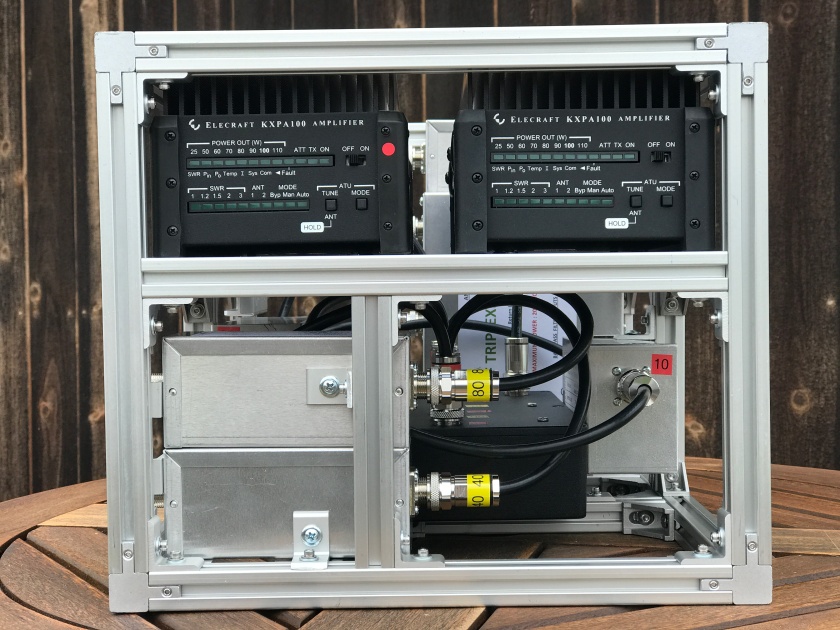
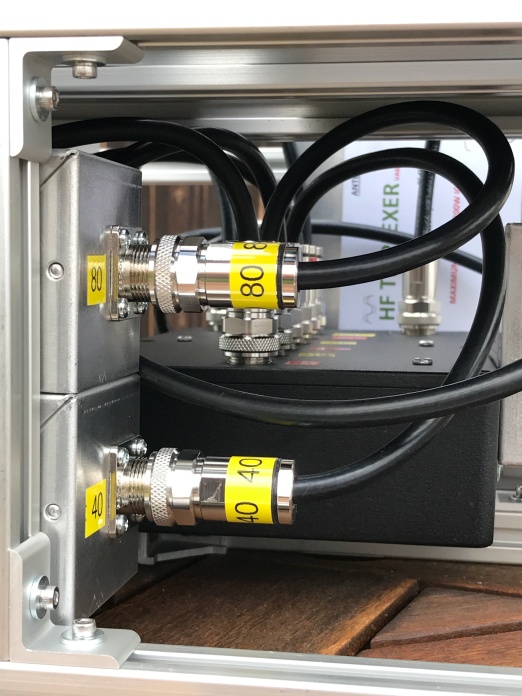

First Contact
Proof of the pudding is in the eating and late Sunday afternoon August 29th KH7HI, while in the Hawaii QSO party nabbed me for 59s each way. Wow!!
Next steps
Maybe it’s big, maybe its bulky but it’s beautiful and performs it’s mission admirably.
Sure, I can dream how to make it smaller, lighter, faster, cheaper…whatever but the truth is right now I should just use it!
…..a Pelican case awaits
Most airlines allow check bags that do not exceed certain weight limits such as 50 Lbs for United (or 70 lbs for me having flown too many United miles in my life) and linear dimensions (I.e length, width and height) that don’t exceed 62 inches.
The Pelican Air 1637 happily wraps itself around the Milk Crate and stays within United’s checked bag limits.

Well I do need to finish of the antenna side of this huge project
This is another journey and documented in separate posts but suffice it to say the goal is a 10-20m HexBeam and two verticals (40m and 80m).

Diet time
I resembled a pack mule on my first SOTA activation and while it was unequivocally fun, it was apparent that the configuration wasn’t going everywhere I wanted such as Boundary or Wheeler peaks.
I feel somewhat the same about the Milkcrate. I love it but is bulk suggests it might not be going everywhere I would like. In fairness I started with the goal of using from the Jeep and hence fixing its max volume to match an existing Jeep container/tote that I already have. Serendipity allowed it to fit in a Pelican and therefore ride the Jet stream at 30,000ft with me but realistically a smaller, lighter and less bulky version would be easy to pick and travel with.
Like iteration one, maybe starting with a volume in mind such as my carry on wheelie given the KX3/PX3 combos fit within a shoulder bag.
Almost 8m of aluminum T20 weighing in at 10.7lbs

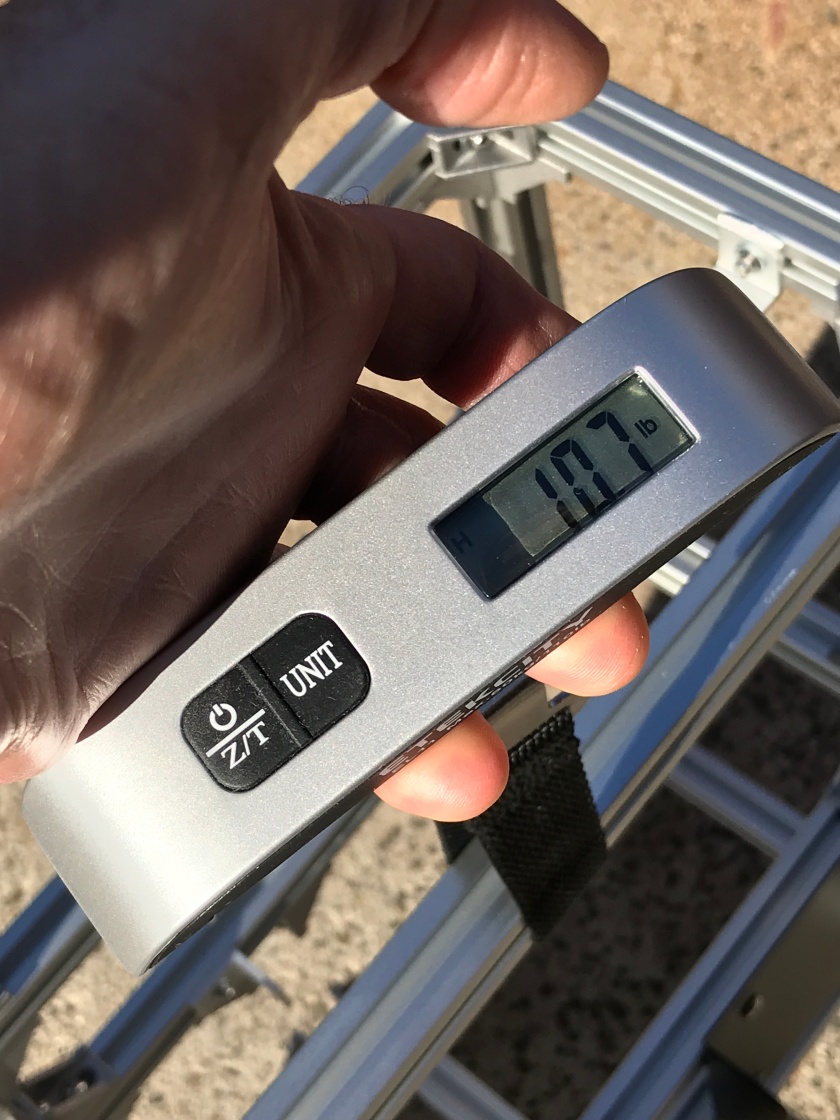
Internal coax cables weighing in at 2.6 lbs
I chose to use Messi Paoloni coax cable given its flexibility and low loose (not really an issue when you have 12″ runs!!). The flexibility was important given the tight quarters I was working with but an unexpected downside was the weight of the connectors and the net net was almost 3 lbs of cables. Reliving the 60s, “that’s heavy, man”

Smaller 100w amps
The KXPA100 weight in at around 6 lbs each and as a pair occupy my only carry on wheelie. Jim Veatch, has created a super small 1 transistor 1w in 100w out amp with heat sink, T/R switch etc that seems the foundation of “diet on” version. Maybe Pavel of VA6AM fame can make me a volume reduced triplexer.
80/40/20/15 only version
This could work well given where we are in the the sun cycle as 10m is less often, if at all open and my success with 160m as a voice operator is really limited calling into question the value of antennas (which are far from physically small for 160m) when traveling via plane. In addition separate antennas for 20 and 15m (versus the HexBeam single feed antenna) would eliminate the need for a triplexer.
Power up to 500w or more
100w typically places us in the Low Power category which can be a less crowded space when operating from a distant locale and therefore increases our chance of placing higher or even winning within our category. The downside is 100w isn’t heard by as many people as a 500w or even 1,500w.
Stepping up power wise isn’t an obvious choice as it’s the domain of some very very well appointed distant stations such as TI5xxx, PJxx that have excellent fixed mono band directional antennas that we can’t possibly compete against as a suitcase bound operation. High score but reduced chance of placing well within our category.
Was it worth the effort?
I’ve learnt so much during this journey especially as I knew absolutely nothing about SO2R, antenna switches when I started.
I have a greater appreciation for the Arduino as a building block for projects. I’ve honed my Maker skills from using chips to creating an enclosure to house a one off project. I’ve learnt tons about RF distribution, switching and antennas and of course I know a lot more about SO2R. I know more about T20, T25 etc aluminum than I thought I would ever know. I have memories but the obvious is I have something that is unique, usable and should offer years of fun.
Optimism and confidence can be a seductive pair and in hind sight I took on considerably more than I realized. Building a 2×6 antenna switch almost from scratch isn’t easy within itself but when its one of so many other things, the sum of the parts became quite daunting.
Occasionally, I wanted to call it quits but my tenacity kept me going plus the overarching realization that failing sets a bad precedence for all the other projects I want to do soon and sooner.
It’s fun to start something but its even better fun to finish it.
Hey, you know those M-series Beemers. Nice cars but one of my projects is to drop a 6.4L V-8 Hemi engine into my Jeep. It’s hard to argue with 500 hp and I think it would be nice to give the Beemer a surprise at the lights. Might not win but the Beemer is going to work hard for their win.


No comments:
Post a Comment